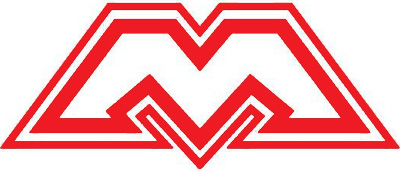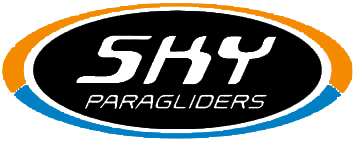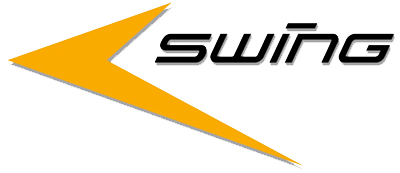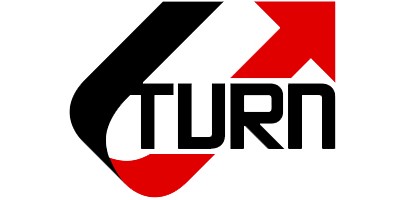Glider repair options
| Repair | Suitability | Visual impact | Guideline price |
|---|---|---|---|
| Patch | Small holes or tears | A patch of self-adhesive ripstop will match the canopy fabric colour closely, but will appear slightly darker when lit from behind. | £5 – £10 |
| Sewn patch | Larger tears or damage nears cell wall seams, leading or trailing edge | Sewing will make a large patch more conspicuous than an unsewn patch. | £15 – £40 |
| Panel section | Significant damage to be repaired cost effectively | The visual impact of an additional seam where the replacement fabric joins the existing panel can usually be minimised. The majority of repairs are made in this way. | £55 – £95 |
| Replacement panel | Extensive damage, or to preserve resale value of a nearly new glider | If the cloth can be exactly matched, the repair will be invisible. If the canopy is less than pristine, the new panel may stand out. | £100 – £200 |
Repair to the top surface near the trailing edge using a panel section
Patch repairs should be inspected regularly to ensure the self-adhesive ripstop tape remains securely attached. All other sewn repairs do not need this kind of checking.
We carry large stocks of fabric to enable a repair to be made without delay and for a reasonable cost. Glider fabrics, and in particular colours, change fairly frequently. Manufacturers can usually supply cloth to match current models, but often an exact fabric match is not available for gliders no longer in production. After a couple of years of use, the canopy colour is likely to have faded and may no longer exactly match new cloth.
Put things back how they should be
If something has happened to your kit, you’ll want to know that it’s strength and performance have been fully restored before you use it again. Once we’ve carefully assessed the damage, we’ll let you know what the options are, how much they would cost and how long the repair will take.
Every repair options we offer will be fully airworthy. The choice will relate the the appearance of the repair. A completely invisible repair is usually possible, but in some cases a more economical option is preferable. The difference might simply mean, for example, that an additional seam might be needed after replacing only the damaged part of the panel, rather than replacing the entire panel.
You may be able to identify exactly what damage needs repairing, but we recommend a full inspection to ensure that all damage is identified and repaired.
What’s involved?
We really need to see your kit to be able to give a quote
You can email us photographs of the damage and we’ll do our best to give an indication of the likely cost, but it’s only when we can see it for ourselves that we can give you a quote. Take a look here to get an idea of the possible cost involved.
You can arrange your own courier or we can arrange collection for you
We want to ensure everything gets fixed properly
We recommend a thorough inspection to ensure that all the damage has been identified. Once we know everything that needs to be fixed, we can assess how much work is involved and what materials are required.
We carry extensive fabric stocks so we can often match exactly or very closely from stock. If it’s necessary, most manufacturers can supply fabric to order within a week or so.
We recommend an inspection to make sure all the damage has been identified
A thorough inspection of the fabric of the canopy costs £40. We can also carry out an inspection of the lines for an additional £30.
If you’re sending in a harness for repair, we can inspect that for £18.
You choose the most appropriate option
A completely invisible repair is usually possible, but in some cases a more economical option is preferable. We’ll recommend what we think is most appropriate, but the choice is yours.
For example, if only one panel is damaged on a fairly new wing, it may make sense to replace the entire panel exactly as is was when new. But if the damage is more extensive, or if the wing is older, then you may choose to have just the damaged sections replaced, even though that means that there may be additional seams visible.
Take a look here to get an idea of the different options.
When we give you a quote we’ll also let you know how soon we think your kit will be ready. The timescale for a repair can vary depending on how much work is involved, what materials might need ordering, and the level of demand from other pilots for repairs. In many cases repairs are completed within two or three weeks, but this can be longer particularly over the busy flying months of the year.
We’ll complete your repair as quickly as possible
We normally only bill when the job is complete and ready to be despatched back to you. We may ask you to pay an element up-front if there’s a significant amount of material that we have to order in especially.
Send your kit in for a quote and estimated time to repair
We recommend a canopy inspection to make sure all the damage is identified
We can also check your lines over at the same time if there’s any concern
We’ll discuss the different options to best meet your requirements
All our repairs will fully restore your glider’s strength and performance
We can arrange collection and return by courier
We have been working for many years with manufacturers from around the world, so we can ensure that every repair leaving the workshop fully meets their specifications.
Repair FAQ
Our goal is to make repairs as inconspicuous as possible
A completely invisible repair is usually possible, but in some cases a more economical option is preferable. We’ll recommend what we think is most appropriate, but the choice is yours. Take a look here to get an idea of the different options for glider repairs.
We’ll always match the fabric as closely as possible, but bear in mind that colours fade through use, so after a couple of years the existing fabric will not longer match its original appearance.
Yes we do
We can repair most aspects of harnesses. As with all other repairs, it’s best to send it in so we can take a look and let you know.
To answer that we really need to examine your kit first
You can email us photographs of the damage and we’ll do our best to give an indication of the likely cost, but it’s only when we can see it for ourselves that we can give you a quote. Take a look here to get an idea of the possible cost involved for glider repairs.
Yes
We match the original construction as far as possible, so your kit should be just as strong and perform in the same way as if the damage had not occurred.
We recommend an inspection to make sure all the damage has been identified
A thorough inspection of the fabric of the canopy costs £40. We can also carry out an inspection of the lines for an additional £30.
If you’re sending in a harness for repair, we can inspect that for £18.
You’re welcome to drop your kit in with us during our working hours, but most pilots use a courier. You can do that yourself, or we can arrange one for you. Let us know when you book in and we’ll make the arrangements. Our courier can collect from either your home or work address, and the charge for most UK addresses is £25. Alternatively you can drop your kit off at one of 2,500 DPD shops (find one here) for £15.
To use either service you must box up your kit to minimise the risk of damage or loss in transit. Equipment send by our courier is covered in transit up to £3,000 by our insurance.
We use DPD Local to collect from and deliver to addresses in the UK. If you ask us to collect your kit, we can make arrangements for DPD to collect from your home or work address on any working day. Alternatively you can drop your kit off at one of 2,500 DPD shops (find one here).
You will need to put your kit in a cardboard box no larger than 1.0m x 0.7m x 0.6m for protection in transit. The maximum weight for one box is 20kg for collections from a DPD shop, and 25kg otherwise.
On the day of collection from your home or work address, DPD should email and text you to let you know the one hour window within which they will make the collection. Their driver will arrive with a sticky label to go on the box and ask for a signature.
We can arrange a collection to get your kit to the workshop, and there are two options:
-
Our courier can collect from your home or work address during working hours. This costs £25 for most UK mainland addresses for shipments up to 25kg
-
If you drop off your kit at one of the 2,500 DPD shops across the country (find one here), the cost is £15 for a box weighing up to 20kg
Return to you once the work is complete costs £20 for most UK mainland addresses for shipments up to 25kg
UK home or work address: collection and delivery charges
| Area | Weight limit (kg) | Timing | Collection | Return |
|---|---|---|---|---|
| Most of the UK | 25 | Next day | £25.00 | £20.00 |
| Highlands | 10 | Two days | £37.50 | £25.00 |
| Isle of Wight | 10 | Two days | £37.50 | £25.00 |
| Scottish islands | 10 | Two days | £44.50 | £27.25 |
| Isle of Man | 10 | Two days | £44.50 | £27.25 |
| Norther Ireland | 10 | Two days | £44.50 | £27.25 |
| Channel Isles | 10 | Two days | £44.50 | £27.25 |
Scottish Highland postcodes are AB36-38, AB55-56, FK17-21, IV1-39, IV52-54, IV63, KW1-14, PA21-40, PH19-26, PH30-41 and PH49-51
Scottish Islands postcodes are HS1-9, IV40-51, IV55-56, KA27-28, KW15-17, PA20, PA41-49, PA60-78, PH42-44 and ZE1-4
When we’ve completed the work on your kit, we’ll email your service report and invoice. Your invoice will detail how you can pay online by card or bank transfer. Once you’ve paid we’ll finalise arrangements to get your kit back to you.
If you’re planning to pick up from the workshop, you can pay when you’re here either by card or cash.
If we have to order anything in specifically for you, we may ask you to pay for that item in advance.
Recent articles
Many of these articles first appeared in SkyWings
Canopy damage that can be easily overlooked
During the last few months the workshop has been very busy servicing wings in anticipation [...]
Glider canopy repairs
In the workshop, we see all sorts of damage that wings suffer, ranging from the [...]
Canopy repairs
Canopy repairs Last month I looked at glider fabrics and factors affecting porosity. We saw [...]
Introduction to Aerofix
Aerofix has been around since the mid 90s, continuing to develop over that time as has the sport of paragliding itself. This article appeared in SkyWings in 2016 shortly after the business was bought by John Warden.

























